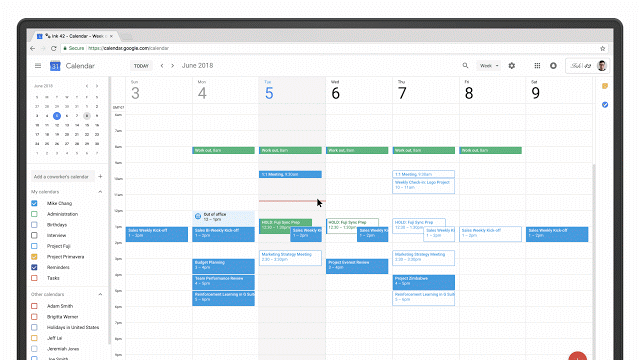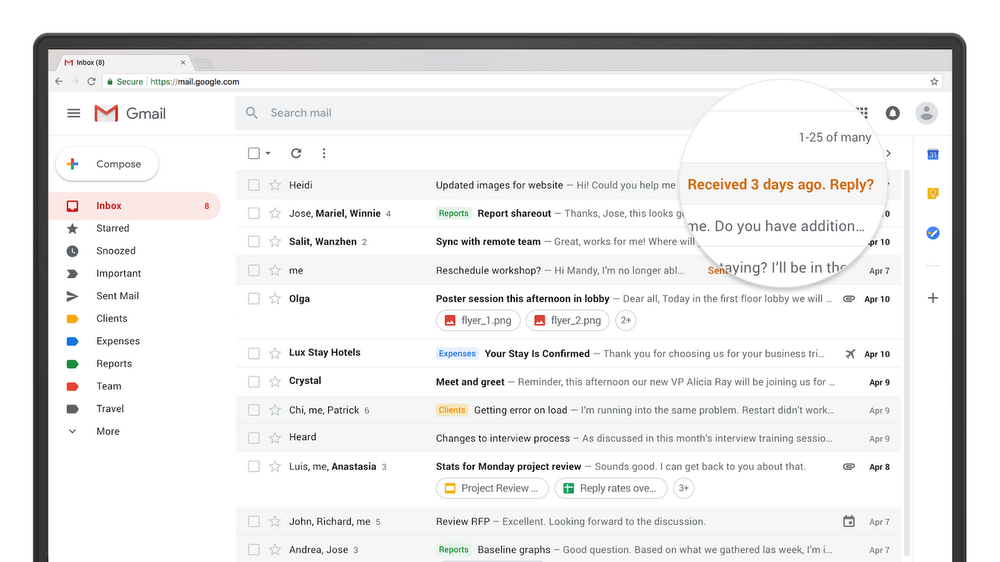In April, Google revealed a new version of Gmail for the first time in several years. In addition to an improved design as well as richer functionality, it includes several new features, most of which come from Google's Inbox. Clearly something exciting is happening at Google.
I have had a G Suite subscription for about six years, and this has included Gmail as a core application. I have always felt that working with the Google G Suite and its apps has been both a pleasant and fluid experience. Personally, I hardly noticed the developments, but, in actuality, Google has constantly been developing its G Suite -- notably its apps and its functions -- little by little.
I can't help but consider this relaunch of Gmail (and subsequent changes) as a good opportunity to take a closer look back at the developments made in G Suite since the release of the new Gmail. In the following overview I will introduce you to some of the innovative highlights from the last three months and I'll also point out new or lesser-known Google apps.
Another excellent source for this sort of information are the G Suite updates on Google's blog:
This official feed from the G Suite team provides essential information about new features and improvements for G Suite customers.
The G Suite team constantly updates this blog letting us know about their most recent innovations and improvements. Speculative articles or discussions about features that are 'currently in development' won't be found here, but instead you'll find out about features that currently available. Updates contain references to new apps and changes to G Suite that have either already been released or are soon to be rolled out. Details about availability, affected payment plans, rollout speeds, the impact on existing systems, as well as actions that may need to be taken by administrators and/or users are included in each article. This is a must read for those interested in keeping up-to-date on what's happening at Google!
Gmail
In April the new Gmail was announced:
Today we're announcing major updates to help the more than 4 million paying businesses that use G Suite work safer, smarter and more efficiently. This includes an all-new Gmail, with a brand new look on the web, advanced security features, new applications of Google's artificial intelligence and even more integrations with other G Suite apps. We're also introducing a new way to manage work on the go with Tasks.
In my earlier blog post, Comparing Google Inbox to the new Gmail, you can read all about the changes and features of the new Gmail.
The new Gmail was available in July, and all users will be automatically migrated to the new Gmail by October at the latest. Since the relaunch we have already seen several other minor updates to Gmail, including automatic reminders for emails (Gmail will now remind you to respond to emails that have been sitting in your inbox for some time) and the new offline capability (you can now work offline in the new Gmail, but unfortunately this is only compatible with the Chrome browser).
Google Tasks
With the relaunch of Gmail came the revival of Google Tasks, only this time it's being pushed into the forefront. The personal task planner has been around for some time, but I hardly know anyone who uses it. In the old Gmail and in Google Calendar, Google Tasks was always there, but in the background. The tool has a web interface, but it looks like something from a decade ago.
In the revised Gmail, Google Tasks is now very visible (via the new sidebar on the right), and there are also Tasks mobile apps for Android and iOS. Since the end of June, Google Tasks has even become a core service in G Suite. For core services, including as Gmail or Calendar, there is guaranteed availability.
Until now, Google Tasks has always had quite a limited set of features to help you manage personal tasks and lists. You can set a date for tasks and define subtasks, but if you're looking for other, fancier functions such as team tasks, assigning tasks, priorities or keywords that have been available in other tools such as Todoist, Microsoft Planner or Asana for a long time, you might be a little disappointed. I suspect, however, that Google Tasks will eventually be upgraded with more features. The joint task management for teams is especially something I can imagine them implementing and it being received very well.
Google Notes (Keep)
The new sidebar also raises the profile of Google Notes. You can use this tool to capture short texts, images and reminders. Labels (keywords) for notes are a nice feature, the web interface is appealing, and there are also apps for Android and iOS. Unfortunately, some of these features can only be used in the Chrome browser. For example, Firefox users need to use the web interface to take notes - or do what I do and use a third-party browser add-on as a workaround (such as Google Keep Notes).
There was one feature in particular that I liked more than Google Tasks: Google Notes supports collaborative note editing. This allows colleagues (or other users) to share notes and edit them at the same time.
Google Calendar
Another core service of the G Suite is Google Calendar, which received a facelift at the end of last year. Google Calendar has consistently been delivering improvements that may not always be considered large or revolutionary. User friendliness has noticeably improved as a result of these small changes.
In the past, it was always difficult to provide participants with additional information when changing appointments - for example, the reason for the appointment change or an adjusted agenda. You can enter this in the event details, but with the each update you had to remember to delete information that was previously entered. For those of us who quickly look at our Google Calendar on the morning of the appointment, we're not usually very interested in why the appointment was rescheduled two weeks ago.
Now it's possible to include a message when changing meeting details in Google Calendar:
This event has been changed with this note:
"Moving the time to accommodate for new team members."
If you work at a busy company, you might find yourself in this situation: you get an invitation for a meeting to be held in two weeks, and the invitation is sent out to a dozen different participants. People are becoming increasingly comfortable with reacting to invitations: at first one person declines to attend, then another. The day before the meeting, the organizer (who also invited everyone) opens their appointment calendar, clicks on the appointment only to realize that everyone has declined to attend! Google Calendar now shows us that all participants have declined with an exclamation mark (!) in the overview of the event. This is not only easier to see but you will save time by not needing to view the details of the appointment.
Some people only realize shortly before an appointment that they had agreed to attend that this event collides with their holiday or business trip. There is now an Out of Office option. When you enter an appointment into your own calendar and enable this option, all incoming invitations are automatically rejected. The "Working Hours" option is similarly useful: colleagues can see immediately that someone is never in the office before 8am, or that they always leave at 1pm because they're a part-time employee. Learn more about managing your work and personal time with Google Calendar.

G Suite - Calendar Out Of Office (Source: G Suite Updates)
For the times when we need to organize appointments with clients of other businesses, there are additional useful features, including hints on how to use Google Meet or Google Hangouts (via links or phone numbers).
Up next
In the second part, I will take a closer look at Google Groups for Business, Hangouts Meet, Jamboard and Google Sites. I'll also include information about new features for admins in Google G Suite.
Lesen Sie diese Seite auf Deutsch
Frank Hamm is a consultant for communication and collaboration who supports companies in their digital transformation. He has written for INJELEA-Blog about social business, intranets, enterprise 2.0 and company communication practices since 2005. Frank is an avowed nexialist and writes about this at Der Schreibende.
is a consultant for communication and collaboration who supports companies in their digital transformation. He has written for INJELEA-Blog about social business, intranets, enterprise 2.0 and company communication practices since 2005. Frank is an avowed nexialist and writes about this at Der Schreibende.
You can find more articles by Frank Hamm in our intranet special.



